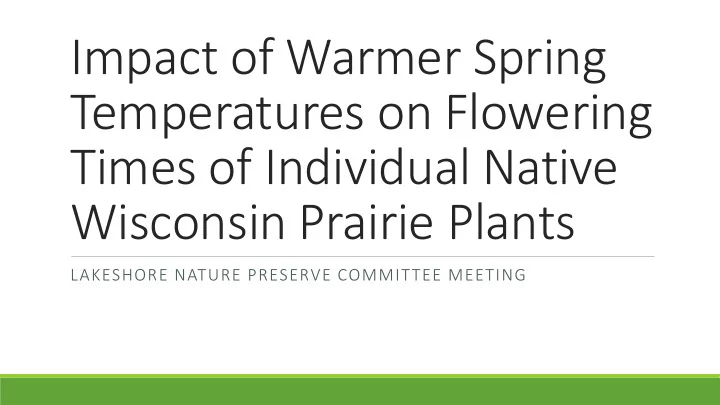

Impact of Warmer Spring Temperatures on Flowering Times of Individual Native Wisconsin Prairie Plants LAKESHORE NATURE PRESERVE COMMITTEE MEETING
Historical Study of Phenology: Aldo Leopold
Background & Biological Rationale • Study of cyclical natural phenomena Historical First Flower vs. Average Spring Temperature Historical First Flower vs. Spring Precipitation 170 170 April-|------- May -------|-------June- April-|------- May -------|-------June- 160 160 First Flower Date (Day of the Year) 150 150 First Flower Date (Day of the Year) spiderwort spiderwort 140 140 prairie phlox prairie phlox 130 130 shooting star shooting star 120 120 110 110 4.00 6.00 8.00 10.00 12.00 0.00 10.00 20.00 30.00 40.00 50.00 Average Spring Temperature (°C) Spring Precipitation (cm) Figure 1: First flowering dates of spiderwort (T. ohiensis, max=162, min=127, mean=148.1), prairie phlox (P. pilosa, max=159, min=118, mean=137.3), and shooting star (P. fassettii, max=147, min=122, mean=134.0). Data were collected in 1935-1945 by Aldo Leopold, his students, and members of his family and in 1977-2012 by Nina Leopold Bradley, Stanley A. Temple, and members of the Aldo Leopold Foundation. A) First flowering date compared to average spring temperature (spiderwort: R2 = 0.4023, F(1, 45) = 30.29, p < 0.001; prairie phlox: R2 = 0.343, F(1, 45) = 23.50, p < 0.001; shooting star: R2 = 0.7029, F(1, 45) = 106.48, p < 0.001). Average spring temperature was calculated using temperatures in March, April, and May. B) First flowering date compared to spring precipitation (spiderwort R2 = 0.0264, F(1, 45) = 1.22, p = 0.275; prairie phlox: R2 = 0.0012, F(1, 45) = 0.054, p = 0.817; shooting star: R2 = 0.0851, F(1, 45) = 4.19, p = 0.047). Spring precipitation includes both rainfall and snowfall for March, April, and May (13). First flowering dates are given as days of the year, where January 1st is day 1.
Methods 1. Identify plants 2. Label with metal stakes 3. Find location coordinates 4. Observe plants 5. Record first flowering date 6. Photograph flower 7. Compare first flowering date to other years (using average spring temperature, spring precipitation, and other variables) Figure 2: Map of the Biocore Prairie with grid overlay. Each of the six lupine (Lupinus perennis) are indicated by a red pin. Their coordinates correspond to their location within the grid: L20, 7.0m E, 7.1m N; L20, 13.5m E, 16.6m N; M20, 19.3m E, 4.9m N; Q17, 1.0m E, 0.0m N; Q17, 3.4m E, 0.0m N; and R18, 2.7m E, 16.9m N.
purple prairie clover meadow rue prairie phlox clasping milkweed 6/19/2016 6/6/2016 6/5/2016 6/9/2016 Photographs 6/27/2017 6/4/2017 6/14/2017 6/12/2017 6/18/2018 6/4/2018 6/4/2018 6/18/2018 Figure 3: First flowers of plants whose flowering dates were recorded in 2016, 2017, and 2018. Each column includes the images for an individual plant in each year of the study: purple prairie clover (Dalea purpurea), meadow rue (Thalictrum dasycarpum), prairie phlox (Phlox pilosa), and clasping milkweed (Asclepias amplexicaulis).
Results & Analysis • No significant relationship between spring temperature and flowering time for individual prairie plants First Flower vs. Average Spring Temperature First Flower vs. Spring Precipitation 2018 2017 2016 2016 2017 2018 1-Jul 1-Jul 26-Jun 26-Jun First Flower Date First Flower Date 21-Jun 21-Jun purple prairie clover purple prairie clover 16-Jun 16-Jun clasping milkweed clasping milkweed prairie phlox prairie phlox 11-Jun 11-Jun meadow rue meadow rue 6-Jun 6-Jun 1-Jun 1-Jun 7 7.5 8 8.5 9 40 50 60 70 80 Average Spring Temperature (°C) Spring Precipitation (cm) Figure 4: Graph of data from 2016, 2017, and 2018. Each line represents an individual plant’s first flowering dates in 2016, 2017, and 2018. A) First flowering date compared to average spring temperature. Average spring temperature was calculated using temperatures in March, April, and May (8.93°C in 2016, 8.21°C in 2017, and 7.21°C in 2018). B) First flowering date compared to spring precipitation. Spring precipitation included both rainfall and snowfall for March, April, and May (41.96 cm in 2016, 48.95 cm in 2017, and 75.21 cm in 2018).
Results & Analysis • Relationship between climatic variables and flowering time is species dependent First Flower in 2017 and 2018 First Flower in 2017 and 2018 31-Jul 31-Jul 16-Jul 16-Jul First Flower Date First Flower Date Flowering Spurge 1-Jul Yellow Coneflower 1-Jul Prairie Blazing Star Butterfly Milkweed Rosinweed Meadow Rue 16-Jun 16-Jun White Prairie Clover 1-Jun 1-Jun 2017 2018 2017 2018 Year Year Figure 4: Graph of data from 2017 and 2018. Each line represents an individual plant’s first flowering dates in 2017 and 2018. Lines of the same color are individuals of the same species. In 2017, average spring temperature was 8.21°C, spring rainfall was 27.84 cm, spring snowfall was 21.11 cm, and total spring precipitation was 48.95 cm. In 2018, average spring temperature was 7.21°C, spring rainfall was 32.16 cm, spring snowfall was 43.05 cm, and total spring precipitation was 75.21 cm. Spring temperatures and precipitation were calculated using values from March, April, and May.
Implications Flowering time Temperature & sunlight Precipitation Winter temperature & snow depth Genetic constraints
Implications Altered flowering time Water uptake Nutrition cycling & carbon sequestration Interactions with pollinators & herbivores
Accomplishments
Thank You!
Recommend
More recommend